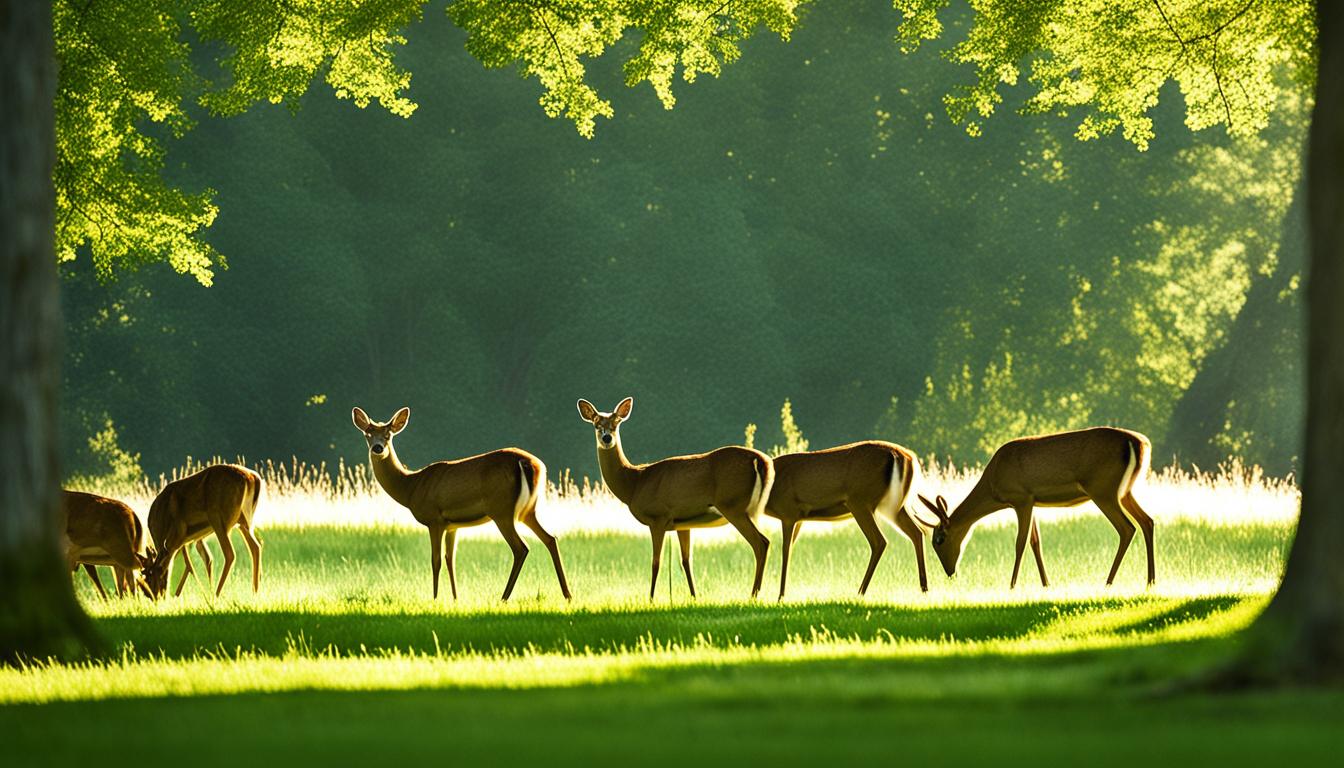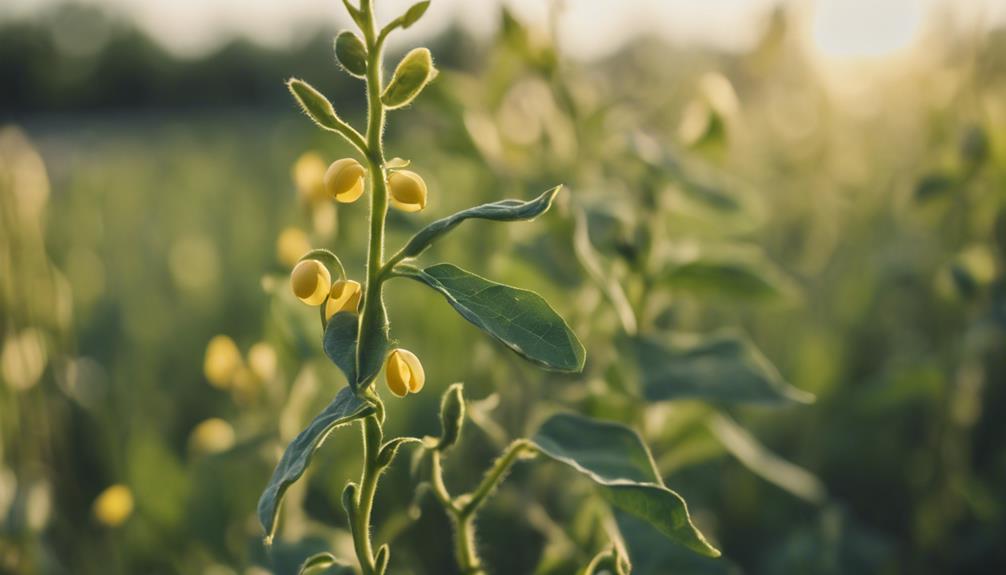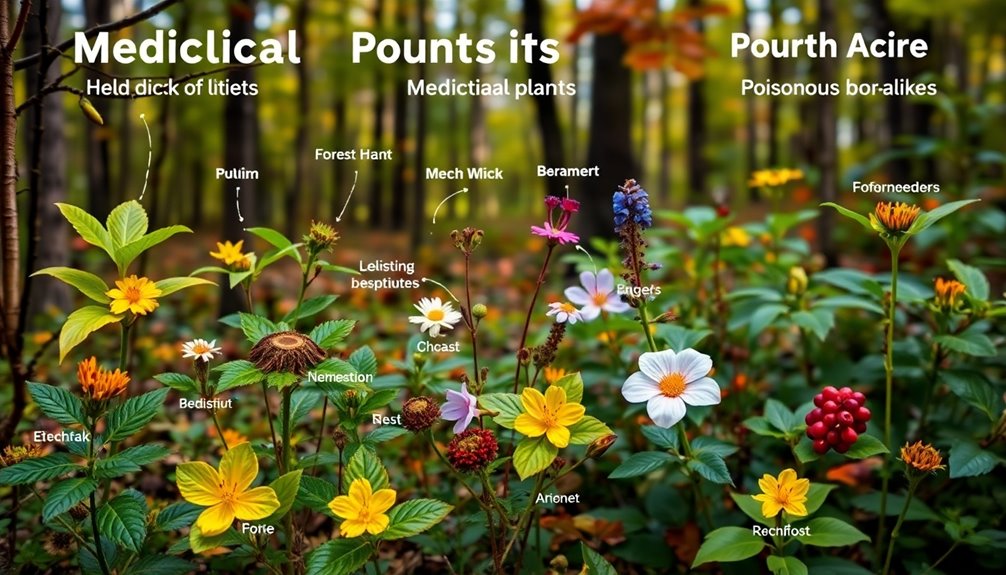Imagine walking in a quiet forest, surrounded by nature’s beauty. Suddenly, you see a beautiful deer eating the green plants. Its smooth actions catch your eye. Have you ever thought about how much food a deer needs to stay healthy and active?
Research shows that the whitetail deer, a common North American deer, eats up to 5 pounds of food daily1. Their diet includes leaves, stems, fresh shoots, and fruits. These foods give them the nutrients they need to live. Deer mainly feed by browsing, which lets them eat a variety of plants.
Key Takeaways:
- Deer can consume up to 5 pounds of forage daily
- Bucks require extra nutrition for rapid antler growth
- Understanding deer traffic patterns is essential for selecting the right location for hunting
The Difference between Deer and Cows in Diet
Deer and cows eat differently because their stomachs work in unique ways. While cows eat lots of plant types, deer pick specific high-quality plants.
Deer have smaller stomachs, needing nutrient-rich food for fast digestion. Thus, they eat plants like Illinois bundleflower and grapevines2. Cows, with bigger stomachs, eat more roughage. They can have up to 30 percent browse in their diet, much like what one deer eats3.
If cattle eat too much browse, they compete with deer for food. This happens with too many cows on the land. Keeping cattle numbers low helps balance food resources3. Also, practices like burning improve land for wildlife by boosting native plants and controlling unwanted trees3.
To manage both deer and cattle, land managers use various tools. They aim to care for the whole ecosystem, keeping it balanced and sustainable3.
Knowing how deer and cows eat helps manage land better. It guides decisions to meet the needs of different animals, supporting a healthy ecosystem.
What Do Deer Prefer to Eat?
Deer have varied tastes and eat different foods based on season and what’s available. They enjoy things like browse, forbs, grasses, nuts, fruits, and mushrooms. Let’s dive deeper into these foods:
Browse
Deer like to eat the leaves and twigs of woody plants, known as browse. In the colder months, deer eat more woody browse for their much-needed calories and nutrients. Woody browse is crucial for their survival during the tough winter4.
Forbs
Forbs are a big part of a deer’s summer eating habits. These plants, often called weeds, are packed with nutrients. They make up about 70% of a deer’s diet in summer5. Deer commonly eat forbs like asters, chickweed, goldenrod, and verbena4.
Grasses
Even though grasses only make up a small part of a deer’s diet, they are still important. Paired with fungi, grasses help round out what deer eat4.
Nuts
Nuts, especially acorns from white oaks, are deer favorites. They are packed with energy, carbs, and fats. This makes them better than corn for giving deer the energy they need in fall and winter6.
Fruits
Deer love fruits like apples, pears, and persimmons. They also enjoy wild grapes, eating both the leaves and the fruit6.
Mushrooms
Deer will eat mushrooms though they are not a big part of their diet. Mushrooms add extra nutrition and variety to their meals4.
Knowing what deer like to eat helps us take care of their habitats. By providing the right food and a diverse environment, we can keep them healthy and thriving in the wild.
| Preferred Deer Foods |
|---|
| Acorns |
| Apples |
| Forbs |
| Grasses |
| Mushrooms |
| Nuts |
| Fruits |

Seasonal Food Preferences of Deer
Deer change what they eat with the seasons, adjusting to what’s available. Hunters, nature lovers, and those managing land need to understand these changes. We’ll look at how deer diets shift and what affects their choices.
In spring, deer recover from winter. They eat lots of nutrient-rich forbs, like young leaves and some mushrooms. These help with muscle, antler growth, and fawn development. They also munch on new buds and tender stems7.
By summer, as plants grow, deer eat more leaves, twigs, and buds from trees and shrubs. This diet is rich in nutrients. They also look for plants with a lot of water to stay hydrated in the heat7.
When fall arrives, deer’s eating habits change again. They enjoy ripe fruits, berries, and corn. White oak acorns are a favorite because they’re less bitter. These foods help them store fat for winter7.
Winter makes food hard to find for deer. They eat twigs, branches, and bark, mainly. Acorns and tree pods help them get through the cold. Making food easy to find can help deer survive the winter78.
Knowing what deer like to eat through the year helps with land management and hunting. By supporting their dietary needs, we can help maintain a healthy deer population. This is good for the whole ecosystem.

References:
- Provided statistical data from link 2:
– White-tailed deer go for protein-rich foods in spring and summer.
– They eat new plants, buds, and mushrooms, along with acorns.
– For hydration, deer choose forbs with lots of water in summer.
– Deer like new soybean plant growth in summer fields.
– In fall, they eat fruits like apples, pears, berries, and corn.
– Deer prefer fall acorns from white oak because they are less bitter.
– During winter, acorns are their favorite food.
– Honey locust tree pods are part of their winter meals.
– Twigs and branches are a big part of their winter diet.
– Understanding what deer eat is key for successful hunting.
Regional Variations in Deer Diet
Deer food choices change based on where they live. This knowledge is key for hunters and those who love wildlife. The types of plants deer like to eat depend on the region, with some plants favored more in certain places.
Different areas favor different plants for deer, as shown by statistics9. A plant loved by deer in one place might not be preferred in another. Knowing what plants deer like in your area is crucial for finding the best feeding spots.
In the Czech forests, data9 reveals Red deer eat mostly broadleaf tree parts, like shoots and leaves. This makes up 71% of their diet. In summer, grasses are a big part of what they eat, up to 70%. Winter sees them eating more heaths and sedges, about 30% to 60% of their diet.
Deer diets also vary with climate and the kinds of habitats available. For example, deer in coastal areas might eat seaweed. Those near farms might eat crops.
While data gives us a good start, seeing what deer eat in different places helps us understand their diets better. We must consider things like the time of year and the characteristics of their homes.

| Region | Browse Plant Classifications |
|---|---|
| Czech forests | Broadleaf tree shoots, leaves, buds, bark |
| Coastal regions | Seaweed |
| Farmland areas | Agricultural crops |
The table shows how different the deer diet can be in various places. But to get the full picture, it’s best to talk to local experts and check out resources specific to the area.
What Deer Prefer to Eat in Your Area
Knowing what deer like to eat where you live helps manage their numbers and health. You can find out about their favorite foods by using resources from state game agencies. Observing deer in their natural habitat is also a good way to learn what they eat.
Deer mainly feed on forbs and browse, with these making up to10 80% of their diet. Forbs are small plants like wildflowers, making up10 25-50% of what deer eat annually. Browse comes from the soft parts of brushes and trees and is10 30-50% of their yearly diet.
Deer will also eat from gardens, crops, and orchards when they can. Though crops are less than 7% of their diet10, natural food sources are preferred. Grass makes up less than 10% of their food because they can’t digest it well.
Adult deer need 6-10% protein, while young ones need 12% for growth. Higher protein, 14-22%, is needed when does are pregnant or feeding young10.
Deer must eat 2% of their body weight in dry forage each day for muscle. For breeding, they need 3-5% of their body weight with a 12-16% protein content10.
In places like the Texas Hill Country, deer might eat more grass, between 7-14% of their diet, because of the area’s unique traits10.
Knowing all this allows landowners and wildlife managers to make wise choices in deer management. They can provide deer with a good mix of food sources for healthier herds11.

Improving the land’s soil health also enhances plant quality for deer. By offering diverse food options, we support deer well-being11.
Effective deer management starts with understanding their diet. Use resources from wildlife agencies and watch deer yourself. This helps ensure the deer and their environment thrive11.
Supplemental Feeding for Deer
Supplemental feeding is vital for a deer’s health and antler growth. It provides essential nutrients and minerals. This is especially important during antler growth and when does rear their fawns.
Deer need much food to live well. According to sources from12, a deer needs about 4 pounds of dry forage each day for every 100 pounds it weighs. To grow big and healthy, whitetails need between 17 to 20 percent crude protein. Dr. Keith Causey suggests giving them a concentrated protein supplement to help them reach their best.
Bucks benefit from protein rations when they shed their antlers. This helps with testosterone production, which is important for their reproduction. Tom Boyer suggests giving 16% protein rations during this time. But, Dr. James C. Kroll warns that deer can’t handle protein rations over 16% well.
Does need more food in winter to support their fawns. Supplemental feeding helps, especially when natural food is hard to find. This is very important for keeping the herd healthy and ensuring many fawns are born.
Adding high-quality feed to a deer’s diet helps their antlers grow and the fawns survive. Based on information from13, deer need about 17% crude protein all year. They typically eat 3-4 pounds of forage daily per 100 pounds of their body weight. This only provides around 8% protein. So, feeding them supplements with higher protein like soybeans helps meet their needs.
Supplemental feeding should be an addition, not a replacement for their regular diet. Natural forage is still the best. Food plots can also help provide what they need throughout the year and even give more than the 17% protein they require.
Though supplemental feeding is good for deer, some states have rules against it. As mentioned in14, 22 states partly or fully ban feeding or baiting deer. But, in states like Texas, feeding deer all year is okay, and it has shown to help hunters see and harvest deer more easily.
Seasonal Deer Feeding Guide
Feeding deer right, based on the season, is key to their health and survival. By giving them the correct nutrients throughout the year, you support their growth, reproduction, and survival in tough times. This guide covers how to feed deer from fall to summer.
Fall Feeding
During fall, bucks get ready for the rut. It’s important to help them stay nourished. Foods like acorns, apples, blackberries, dried soybeans, wheat, and turnips are great. They give bucks the energy they need to prepare for breeding season15.
Winter Feeding
In winter, green plants are hard to find. Deer need more food to make it to spring. They need carbs and fats to save energy. Foods like soybeans, corn, nuts, and acorns give them what they need. However, too much corn can cause digestion problems16.
Spring Feeding
Spring is important for deer. They need the right food for antler growth and to feed fawns. Their diet includes things like elm twigs, clover, soybean leaves, and green forbs. Clovers are great because they’re full of protein. During April, May, and June, adult bucks can grow their antlers really fast1516.
Summer Feeding
Summer can be tough for deer because of the heat and not much food. They need foods full of energy and important minerals. Protein, calcium, and phosphorus are vital. A mix of natural forage and extra feeds can help deer stay healthy in summer16.
Different deer might need different foods, depending on where they live and their habitat. It’s good to talk to local wildlife experts for the best feeding advice. By feeding deer correctly through the year, you help them stay healthy and keep their populations strong. Check out sources15 and16 for more information.

Deer Food Plots
Supplemental feeding helps deer get the nutrients they need for health and growth. It’s also key to set up food plots with plenty of native vegetation17.
Deer food plots have selected crops that deer normally eat. This helps fill the gap between natural food and supplemental feeds. These plots give deer food all year round17.
When making a deer food plot, think about what deer like to eat. There are four types of forage used in these plots: perennials, warm-season annuals, cereals, and brassicas17. By mixing these crops, deer get a varied diet that meets their needs all year.
| Category | Example Crops |
|---|---|
| Perennials | Clover, alfalfa, chicory |
| Warm-Season Annuals | Sorghum, millet, soybeans |
| Cereals | Oats, wheat, rye |
| Brassicas | Turnips, radishes, kale |
Hunters often plant two types of plots: hunting plots and nutritional plots. Hunting plots have crops like brassicas. They’re great for cold weather. Nutritional plots have clover and beans. They offer food all year17.
Before planting, test the soil to see what it needs. Fixing the soil based on these tests helps crops grow better. It’s also crucial to remove weeds and prepare the ground well for seeding17.

In sum, deer food plots are important for managing deer. By planting the right crops, these plots offer extra food and year-round nutrition. Whether for hunting or nutrition, a mix of crops gives deer the diet they need all year17.
Tree Stand Tips for Deer Hunting
Placing your tree stand correctly is key to deer hunting. Using effective strategies and the right gear can boost your success. Keep these tips in mind for a better hunt.
1. Choose the Right Location
Picking your tree stand’s spot is crucial18.Data shows food plots cover a lot of visible area but are only 6% of the landscape. Hunting near food plots can help, but deer usually avoid these spots during legal hunting hours. Does, however, may visit food plots in daylight more than bucks. Also, setting up in natural pine areas could offer cover and food without attracting too much deer attention anytime.
2. Consider Hunting Pressure and Timing
It’s important to understand hunting pressure and timing. The site studied saw 5 hours of stand time per 250 acres weekly. To keep food plots effective, try to visit them less often. Bucks and does prefer food plots at dusk after the breeding season. Timing your hunts can make a big difference.
3. Prioritize Doe Harvest
Focusing on doe harvest helps manage deer populations. On the studied property, does were harvested at twice the rate of bucks. For bucks, consider having stands just for them. By targeting does near food plots, you’ll help balance the deer population.
4. Pay Attention to Deer Movement
Watching how deer move is key18.They leave food plots before dawn but return before sunset. Knowing when and where deer roam can guide your hunting strategy. Figure out their active times for the best chances from your tree stand.
Smart tree stand placement, choosing the best hunting gear, and following these tips can greatly improve your hunt. By understanding deer patterns, managing hunting pressure, and picking the best locations, you’re set for a rewarding season. Good luck hunting!

Conclusion
It’s very important to know what deer eat and how to feed them correctly. This helps manage deer populations well. In young forests, deer food can weigh up to 1,000 pounds per acre. But in thick forests, the amount drops to 100 pounds or less19. It’s better to grow native plants than to give deer food that’s not natural. This way, deer can eat a variety of plants that give them the protein and nutrition they need.
Some plants are super good for deer because they have a lot of protein20. Plants like Brazilian Vervain and Common Ragweed have 10% to 24.3% protein19. Knowing which plants deer like to eat helps people who take care of land or love wildlife. They can make places where deer have the right kinds of food to eat.
Deer look for food 5 times a day, and eating in the afternoon and just before night is very important for them21. They choose the best food to eat once a day, around an hour before it gets dark21. If we manage where deer sleep and give them good food in the afternoon, we can help deer move in ways that are good for both them and hunters21. By understanding their natural patterns, we can better predict their movements and ensure that deer have access to nourishing food sources at the right times. So, **do deer forage at night**? Yes, deer are known to forage during the night, especially in areas where they feel safe, but their most critical feeding moments often occur in the late afternoon and just before dusk. Understanding *deer nighttime foraging habits* can provide valuable insight for hunters and wildlife enthusiasts alike. While deer do forage at night, their behavior is influenced by factors such as habitat, predation risk, and food availability. By analyzing both their daytime and nighttime patterns, we can support effective management strategies that align with their natural feeding rhythms.
In short, feeding deer the right way means knowing what they naturally eat, growing a mix of plants, and fitting into their normal eating habits. By doing this, people who own land or manage wildlife can help deer live well. This also helps keep hunting sustainable.
FAQ
How much forage does a deer eat?
What is the difference between deer and cows in diet?
What do deer prefer to eat?
What are the seasonal food preferences of deer?
Are there regional variations in deer diet preferences?
How can I determine what deer prefer to eat in my area?
How does supplemental feeding benefit deer?
What are the seasonal feeding strategies for deer?
How do deer food plots help provide nutrition throughout the year?
What are some tips for tree stand placement in deer hunting?
Do I need to consider responsible feeding practices for deer?
Source Links
- https://www.tractorsupply.com/tsc/cms/life-out-here/outdoor-life/hunting/feeding-big-game-for-hunters-and-nature-lovers – Deer Feeding 101: What Do Deer Eat
- https://www.buckmanager.com/2007/08/17/what-do-deer-eat/ – What do Deer Eat? Whitetail Food Sources by Season
- https://www.noble.org/regenerative-agriculture/pasture-and-range/grazing-management-benefits-cattle-and-deer/ – Grazing management benefits cattle and deer – Noble Research Institute
- https://www.outdoorlife.com/conservation/what-do-deer-eat/ – What Do Deer Eat?
- https://www.fieldandstream.com/conservation/what-do-deer-eat/ – What Do Deer Eat? Top 20 Favorite Foods
- https://www.themeateater.com/wired-to-hunt/whitetail-management/10-natural-food-sources-every-deer-hunter-should-know – 10 Natural Food Sources Every Deer Hunter Should Know
- https://outdoor.wildlifeillinois.org/articles/white-tailed-deer-seasonal-food-preferences – White-tailed Deer Seasonal Food Preferences
- https://www.northamericanwhitetail.com/editorial/whitetail-nutrition-calendar/263409 – Annual Deer Diet: What & When – North American Whitetail
- https://www.wildlifeonline.me.uk/animals/article/red-deer-diet-feeding-behaviour – Red Deer Diet & Feeding Behaviour | Wildlife Online
- https://landassociation.org/what-do-deer-eat/ – What do Deer Eat? Deer Diets Explained – Texas Landowners Association
- https://www.whitetailobsessionoutdoors.com/blogs/2021/12/19/extremely-good-habitat-for-deer-and-wildlife – Extremely Good Habitat For Deer And Wildlife — Whitetail obsession outdoors
- https://mossyoakgamekeeper.com/hunting/deer-hunting/supplemental-feeding-whitetails/ – Supplemental Feeding | Mossy Oak Gamekeeper
- https://www.mossyoak.com/our-obsession/blogs/deer/supplemental-feeding-and-mineral-use – Supplemental Feeding and Mineral Use
- https://texnat.tamu.edu/files/2017/02/EWF-032-Supplemental-Feeding-of-White-Tailed-Deer.pdf – PDF
- https://blog.redmondhunt.com/seasonal-deer-food-source-mineral-schedule – Seasonal Deer Food Sources & Mineral Schedule
- https://www.moultriefeeders.com/blog/deer-eat-each-season/ – What Do Deer Eat During Each Season?
- https://www.deercreekseed.com/tools-n-guides/post/whitetail-deer-food-plots-for-beginners.html – Whitetail Deer Food Plots for Beginners
- https://deerassociation.com/how-to-hunt-food-plots-maybe-dont/ – How to Hunt Food Plots: Maybe Don’t | National Deer Association
- http://extension.msstate.edu/sites/default/files/publications/publications/p3618_web.pdf – A Guide to Common Native Deer Forages in Mississippi and the Southeast
- http://extension.msstate.edu/publications/guide-common-native-deer-forages-mississippi-and-the-southeast – A Guide to Common Native Deer Forages in Mississippi and the Southeast
- https://www.whitetailhabitatsolutions.com/blog/attracting-deer-herds-day-and-night – Attracting Deer Herds Day and Night










